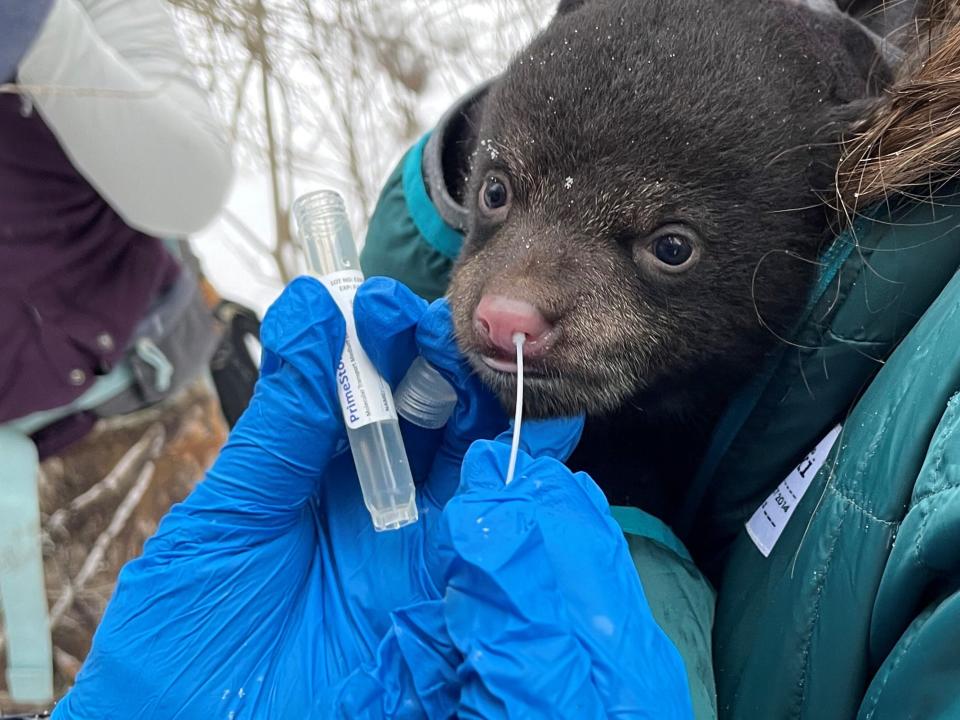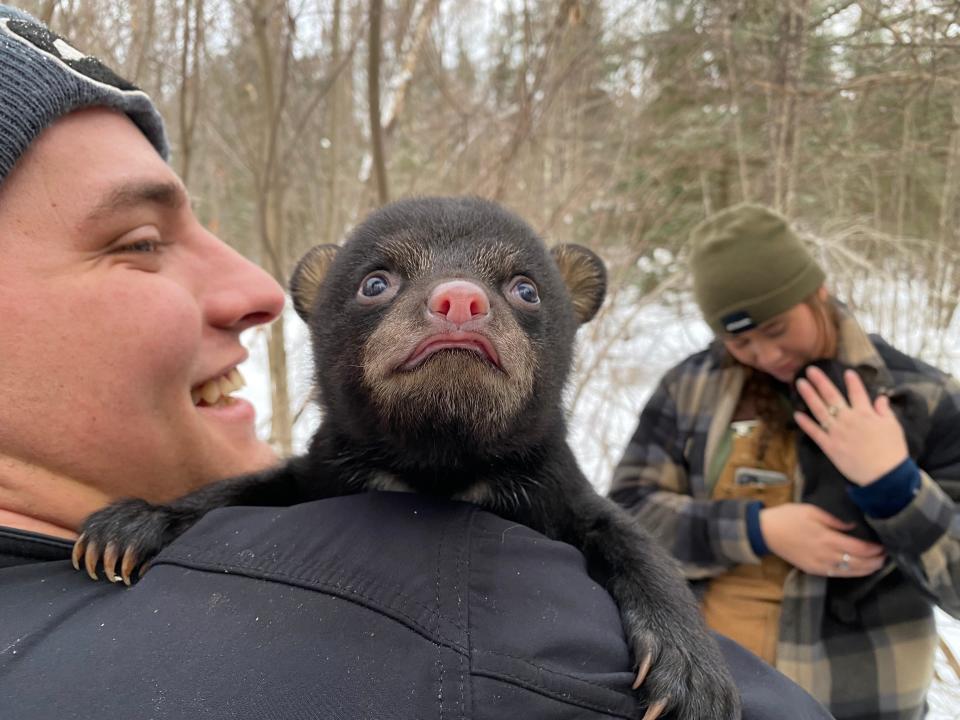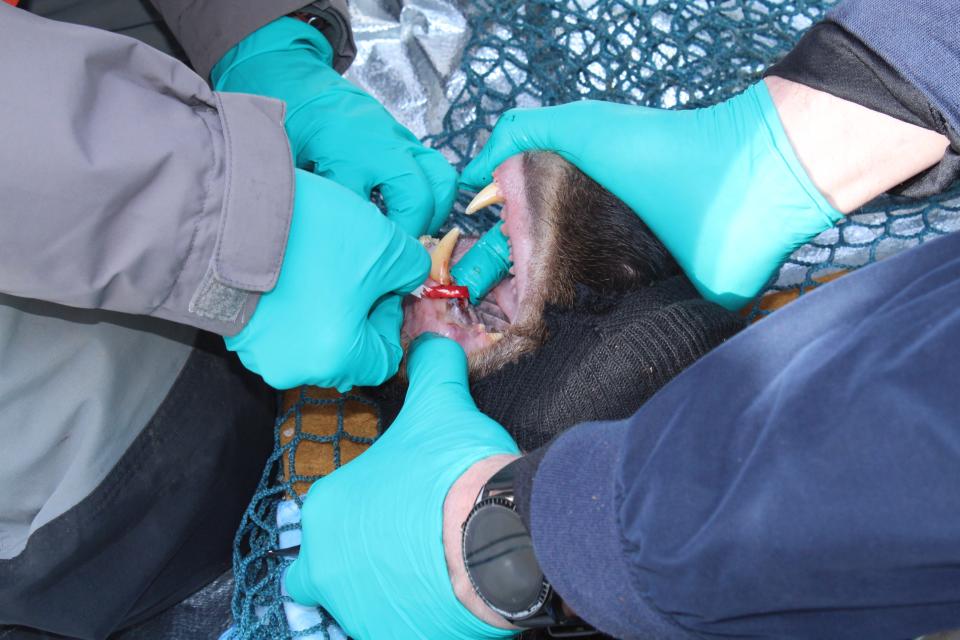Researchers sample bears, deer for COVID-19 to see how the virus spreads
CLAM LAKE, Wisconsin — Testing a black bear for COVID-19 doesn’t look much different from doing an at-home rapid test on yourself.
Prepare the testing solution in a tube. Unwrap a swab. Insert into your nose and swirl it around for a few seconds; repeat on the other side. Put the swab into the tube of the testing solution and prepare it for shipment to a United States Department of Agriculture lab in Colorado.
But, of course, there’s a big difference: researchers need to get close enough to a wild carnivore to actually take the swab, and keep them calm for the duration of the not-so-pleasant swabbing process.
But that's a challenge researchers undertook this winter in northern Wisconsin, in order to see if the virus may have spread into the black bear population and to get at the wider question of whether wildlife can harbor the SARS-CoV-2 virus in a way that leads to new vaccine-evasive mutations that could skip to humans.

Since the outbreak of COVID in humans in 2020, cases have popped up among animals, too.
A few tigers and gorillas in zoos. Some domestic dogs and cats. And in mink farms, the virus spread like wildfire, causing farmers to cull entire populations after the virus was proven to have jumped into at least one employee.
But slowly, cases of COVID have popped up in wild animals, too. White-tailed deer have spread the virus among their populations, as have mule deer.
But scientists are still trying to understand what species might be susceptible and why.
So in early March, a USDA biologist marched into the woods near Clam Lake with a team of researchers aimed at finding bear dens and gathering information about what lay inside. The sows were gently sedated, then pulled from the dens, weighed and given a GPS collar if necessary.
And while the den researchers worked, the bear could be swabbed for COVID by the USDA biologist, and a blood sample taken to test for antibodies, or proof of past infection. The cubs, too, were able to be swabbed, before being gently returned to their den, with their slumbering mother.
“This research is aimed at helping us better understand how COVID is spreading within and across wildlife populations,” said Jonathan Heale, a USDA staff wildlife biologist.
“Our biggest concern is that the animals will serve as reservoirs for the virus. It can hide out, mutate and reemerge with a new variant. So the work on carnivores is a snapshot of what’s going on across the country.”
Testing animals for COVID can help researchers learn more
Testing wild animals for COVID is an important way researchers are learning more about how the disease spreads and mutates.
Can it easily spread between members of the population? And if so, are there mutations? And could those mutations be passed to and sustained by humans?
The samples gathered in early March will help scientists understand if there's a risk the virus could mutate and then spread back to humans.
"It's really dynamic. We can expect that there will be mutations that pop up and a lot of them won't be very successful at being transmitted and maintained in populations of animals," Thomas Yuill, a professor emeritus of pathobiological science, forest and wildlife biology at the University of Wisconsin-Madison.
"But there's always the risk that one might pop up, that in fact can spread very readily. And if it turns out that in the mutation process, its virus structure is changed enough that use of the vaccines or previous exposure might not cover it. So suddenly, you might have people or animals getting infected more than once."

As for the USDA study on carnivores, the agency has sampled mink, raccoons, red foxes, coyotes and some other smaller meat-eaters. They may also conduct some sampling on wolves in Alaska, Heale said.
The testing should be looked at as a preliminary study, Heale said, just trying to see what’s out there and which species even have the biological ability to be infected with the virus that causes COVID.
“We’re testing the waters,” he said. “And if we see more COVID than we thought, we have the capability to conduct more samples.”
So far the testing of black bears hasnot produced any positive tests or findings of antibodies in their blood, though sampling results from March are not in yet.
The lack of COVID in bears may be due in part to a lack of interaction with humans, unlike deer that are commonly seen in neighborhoods or backyards, Yuill said.
“Animals that tend to be very isolated are unlikely to sustain transmission in a population,” he said. “Because the virus can’t find itself from one individual who is infected to the next one.”
Outside of wild animals, there have also been some cases of cats and dogs in Wisconsin getting sick.
In Wisconsin, white-tailed deer also under surveillance
So far, 28 states have had cases of SARS-CoV-2 in wildlife, according to USDA data. Wisconsin is one of them, with one white-tailed deer testing positive for the virus and having antibodies in the southeastern part of the state.
Wisconsin has received results for 143 deer, said Lindsey Long, a wildlife veterinarian with the Wisconsin Department of Natural Resources.
She said samples are being taken to track the spread of the virus in the population.
“Variants have been found in deer populations, and we want to know if it’s persisting, if it’s circulating still. Are we finding new variants?” Long said. “Could deer serve as a reservoir for new introductions?”

Long said they’re trying to also figure out how the virus got into deer to begin with.
“Research suggests multiple introductions into the population,” she said. “How are these introductions happening? And what can we do, how can we start mitigation strategies?”
The second round of sampling is underway in Wisconsin, on deer harvested by hunters, roadkill and deer that have been removed from areas like airports. More than 523 samples have been collected so far, Long said.
Other states are also looking at deer, and other species as well. And other countries, too.
In Canada, studies have found that white-tailed deer likely contracted SARS-CoV-2 from humans, and are now spreading the disease among themselves. According to the Canadian government, there has been at least one case where transmission from a deer to a human was suspected, but it was isolated.
As far as avoiding spreading or contracting the SARS-CoV-2 virus from an animal, following the same guidelines of staying home when sick or wearing a mask apply. Also, make sure you’re throwing trash away properly, too, Heale said, and don’t feed bears or deer.
Laura Schulte can be reached at leschulte@jrn.com and on Twitter at @SchulteLaura.
This article originally appeared on USA TODAY: Researchers sample bears, cubs for COVID to see how virus spreads

